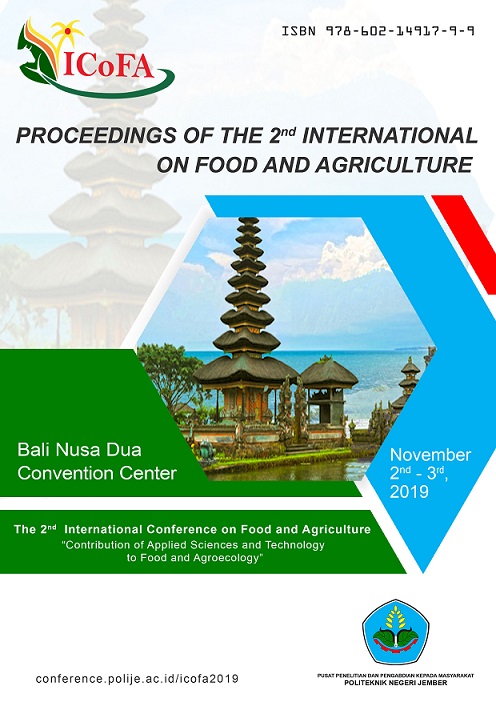QUALITY OF RICE STRAW SILAGE WITH VARIOUS ADDITIVES
Abstract
Rice is a staple food for Indonesian people. Rice straw is waste produced from rice plant when harvesting. Rice straw can be utilized as feed for livestock especially ruminant. Silage is fermentation technology for preserving roughage such as rice straw. In making silage, additive is needed to maintain lactic acid bacteria for successful fermentation. The aim of this study was to evaluate the effects of various additives (rice bran, glucose and molasses) for three different varieties of rice crop. Rice varieties used were Inpari 30, Inpari NutriZinc and Rindang. This study was conducted in a Completely Randomized Design (CDR) with 4 treatments and 3 replications. Each variety was given treatment T0 = Rice Straw + Lactic Acid Bacteria (Lactobacillus plantarum 1A2); T1 =Â T0 + Rice Bran 5%; T2 = T0 + Glucose 2%; T3 = T0 + Molasses 5%. The parameter observed were, pH, temperature, dry matter, ash, crude protein, crude fat and crude fiber. The data obtained are analyzed by analysis of variance (ANOVA) followed by Duncan Test. The results shown that the treatments significantly affect on pH, dry matter, ash, crude protein, crude fat and crude fiber. It was concluded that Inpari 30 was the best variety because it had the highest crude protein content 10.24% and rice bran was the best additive to produced best quality silage compared with other additives.References
. Hartono R, and Kurniawan T 2009 Produksi Biogas dari Jerami Padi dengan Penambahan Kotoran Kerbau, Prosiding Seminar Nasional Teknik Kimia Indonesia-SNTKI 2009, Bandung.
. Statistic Indonesia 2018 Ringkasan Eksekutif Luas Panen dan Produksi Beras di Indonesia 2018. Jakarta. 05110.1806.
. McDonald P, Henderson N, and Heron S 1991 The Biochemistry of Silage. 2nd edn. Chalcombe Publications; Marlow, Bucks, England.
. Henderson N 1993 Silage additives. Anim Feed Sci Technol. 45: 35–56.
. McDonald P, Edwards R A, Greenhalgh J F D, Morgan C A, Sinclair L A, Wilkinson R G 2011 Animal Nutrition. 7th edn. Pearson; Harlow, England.
. Pelczar M J Jr, and Chan E C S 1988 Dasar-Dasar Mikrobiologi. Volume ke-1,2. Hadioetomo R S, Imas T, Tjitrosomo S S, Angka S L, penerjemah; Jakarta: UI Pr. Terjemahan dari: Elements of Microbiology.
. Muck R E, and L Kung Jr 1997 Effect of silage additives on ensiling. Pages 187–210 in Proc. Silage Field to Feedbunk North Am. Conf., Hershey, PA. Northeast Regional Agricultural Engineering Service, Ithaca, NY.
. Kung L, Shaver R D, Grant R J, and Schmidt R J 2018 Silage review: Interpretation of chemical, microbial, and organoleptic components of silages. Journal of Dairy Science,
(5), 4020–4033. doi:10.3168/jds.2017-13909.
. Trabi E B, Xianjun Y, Junfeng L, Zhihao D, Assar A S, and Tao S 2017 Effect of Glucose and Lactic Acid Bacteria on the Fermentation Quality, Chemical Compositions and in vitro Digestibility of Mulberry (Morus Alba) Leaf Silage. Pakistan J. Zool., 49: 2271-2277.
. Li J, Shen Y, and Cai Y 2010 Improvement of fermentation quality of rice straw silage by application of a bacterial inoculant and glucose. Asian-Australasian Journal of Animal Sciences., 23: (7), 901–906.
. Weinberg Z G, Richard E M, Paul J W, Yaira C, and Mira G 2004 Lactic Acid Bacteria Used in Inoculants for Silage as Probiotics for Ruminants. Applied Biochemistry and Biotechnology, 118: (1-3), 001–010.
. Indonesian Center for Rice Research, 2019. SK: 168/HK.540/C/01/2019. http://bbpadi.litbang.pertanian.go.id/index.php/varietas-padi/inbrida-padi-sawah-inpari/inpari-ir- nutri-zinc
. Reddy G V K, and Reddy M R 1989 Nutritive value of rice straw (Oryza sativa) ensiled with animal excreta and rumen digesta. Animal Feed Science and Technology, 24: (1-2), 69–81. doi:10.1016/0377-8401(89)90021-7.

